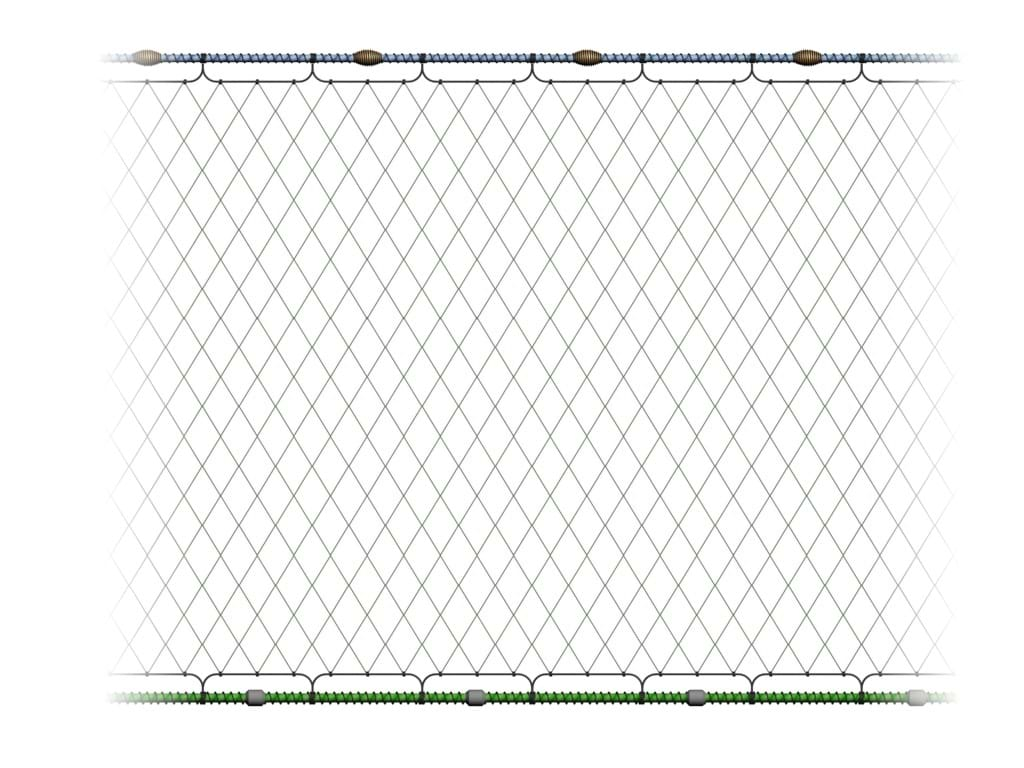Gill Nets
Alternative names
-
- set nets
Summary
A gill net is a single wall of netting anchored on the seabed to catch fish that swim into it.
Gill net is also collective name for many different styles of nets as well as being a style of net in itself. Many of these nets will be referred to differently in different fisheries. (Gill nets, Tangle nets, Wreck nets, Drift nets, Trammel nets etc)

Environmental impact
All gill nets are fairly size selective as the size range of fish caught can be regulated by the mesh size used. Small fish will swim unhindered through the mesh whereas larger ones will be caught. Often the very large fish will 'bounce' off the net without getting caught in the net. Gill nets are also species selective due to the area that they are shot in, the skipper will use his experience to place his gear where he expects there to be an abundance of the target species thereby reducing the chances of by-catch.
There can be problems with cetacean by catch in some areas but in most fisheries the skippers are already aware of this and have adopted the use of acoustic pingers to keep the cetaceans away from the gear. In many fisheries today the use of pingers is mandatory.
Seabed contact with gill nets is limited to very light contact from the footrope and minimal contact from the small anchors at each end. As the gear is not towed over the seabed there should be very little abrasion. There has been reports of problems with ‘ghost fishing’ in the past, this is where the nets are lost and continue fishing for some time after they are lost. There have been attempts to mitigate this by encouraging fishermen to report lost gear so that it can be retrieved at a later date and to bring ashore any badly damaged gear for disposal. It has also been found that in many areas, lost nets will very quickly get entangled with weed and become visible to the fish and eventually sink to the seabed. However lost nets still remains a problem for fish and marine mammals.
Other information
The procedure used when fishing fixed nets is similar whether gill, trammel or tangle nets are being used. The nets are usually fished in groups (referred to as tiers or fleets by industry) with the end of each fleet attached by bridles to a heavy weight or anchor on the seabed. Each weight or anchor is secured to a marker buoy or dhan flag on the surface by a length of rope equal to about twice the depth of water. Depths of water fished can be from 15 metres to 140 meters, with some fisheries going as deep as 1800 metres (deep-water monk and tangle nets).
Length of nets can vary from 50 metres to 200 metres and length of fleets from 300 metres to 2000 metres. The amount of netting being fished (set on the seabed) at any one time can range between 2 kilometres and 30 kilometres and soak times (the time a fleet is left on the seabed to fish) can range from a 6 hour tidal soak to 72 hours. These figures are dependent on which species are being targeted and whether there is any conflict with other boats using mobile fishing gear in the area.
The nets are shot whilst steaming into the tide and are fished along the direction of the tidal stream, rather than across it (there are some exceptions to this). This reduces the chances of the nets being swept over or tangled in the strong tidal conditions found in many areas of the UK. The dhan is thrown overboard and the vessel steams away from it paying out the rope until it reaches the anchor which is quickly dropped overboard. The fleet of nets follows until the full length of netting has run out and the second anchor and dhan follow. Retrieval of the gear is carried out in the same order with first the dhan, then the anchor and net followed by the remaining anchor and dhan. Virtually all boats now use net haulers to help them retrieve the gear. The basic design consists of a rotating drum covered with rubber, which is driven by a hydraulic system run off the main engine. The rubber grips the net, allowing the hauler to take the strain of the net and pull it aboard. Variations on the basic design include belts or rubber spheres, which exert pressure on top of the netting creating more friction with the lower drum and the netting making it easier to haul the net.
Documents
-
Report on the Current State of Driftnet Fisheries in the UK
-
Gill net and other set net fisheries in Cornwall (including Plymouth)
-
Trial of acoustic deterrents for prevention of porpoise by-catch (porpoise pingers) Phase 1 - Deployment trials
-
Trial of acoustic deterrents for prevention of porpoise by-catch (porpoise pingers) Phase 2 and 3 Endurance and Tangle
Gear classification
Main target species (UK)
-
- Any demersal species
- Cod
- Dogfish
- Haddock
- Hake
- Megrims
- Monkfish
- Pollack (Lythe)
- Skates
Possible bycatch
-
- Any demersal species
- Cetaceans